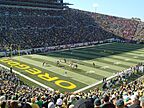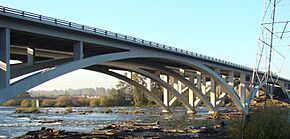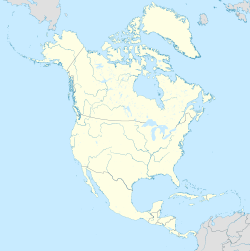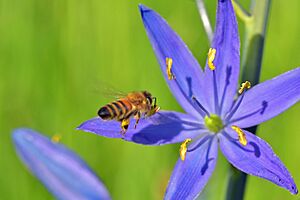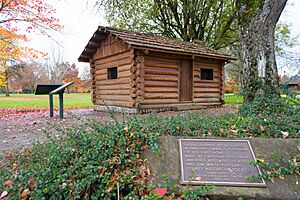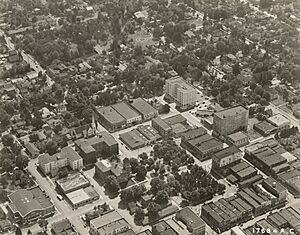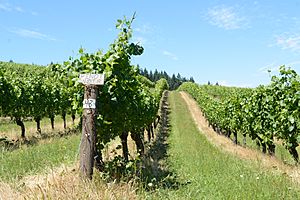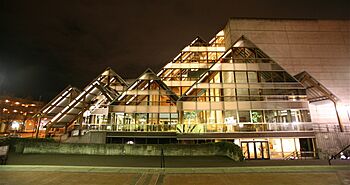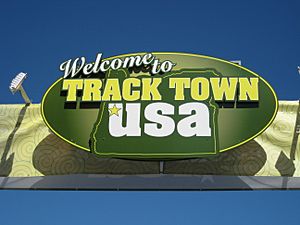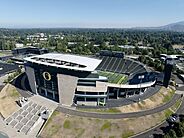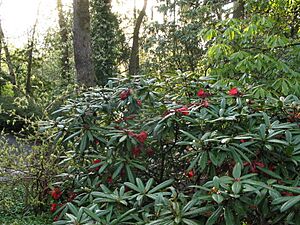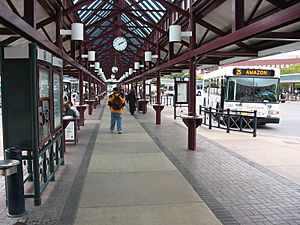Eugene, Oregon facts for kids
Quick facts for kids
Eugene, Oregon
|
||
|---|---|---|
|
Clockwise from top: Panorama taken from Skinner Butte, the Lane County Farmers Market, Whilamut Passage Bridge, University of Oregon Autzen Stadium
|
||
|
||
| Nicknames:
Emerald Valley, The Emerald City, Track Town USA
|
||
| Motto(s):
A Great City for the Arts and Outdoors
|
||
| Country | ||
| State | ||
| County | Lane | |
| Founded | 1846 | |
| Incorporated | October 17, 1862 | |
| Government | ||
| • Type | Council–manager | |
| Area | ||
| • City | 44.29 sq mi (114.70 km2) | |
| • Land | 44.22 sq mi (114.52 km2) | |
| • Water | 0.07 sq mi (0.18 km2) | |
| Elevation | 413 ft (126 m) | |
| Population
(2020)
|
||
| • City | 176,654 | |
| • Rank | US: 148th | |
| • Density | 3,995.07/sq mi (1,542.50/km2) | |
| • Urban | 270,179 (US: 151st) | |
| • Urban density | 3,676.6/sq mi (1,419.6/km2) | |
| • Metro | 382,971 (US: 146th) | |
| Demonym(s) | Eugenean; Eugenian; Eugenite | |
| GDP | ||
| • Metro | $20.913 billion (2022) | |
| Time zone | UTC−08:00 (PST) | |
| • Summer (DST) | UTC−07:00 (PDT) | |
| ZIP Codes |
97401–97405, 97408, 97440
|
|
| Area code(s) | 458 and 541 | |
| FIPS code | 41-23850 | |
| GNIS feature ID | 2410460 | |
Eugene (/juːˈdʒiːn/ YOO-jeen) is a city in Oregon, USA. It is the main city of Lane County. Eugene is located in the southern part of the Willamette Valley, near where the McKenzie and Willamette rivers meet. It's about 50 miles (80 km) east of the Oregon Coast.
Eugene is the second-largest city in Oregon. In 2020, about 176,654 people lived there, and the city covers about 44.21 square miles (114.50 km2). The larger Eugene-Springfield area is also the second-biggest in Oregon, after Portland.
The city is home to the University of Oregon, Bushnell University, and Lane Community College. Eugene is famous for its beautiful nature and many outdoor activities like bicycling, running/jogging, rafting, and kayaking. It also has a strong focus on arts. Eugene's official motto is "A Great City for the Arts and Outdoors." People also call it the "Emerald City" and "Track Town, USA" because of its green environment and love for track and field. The famous Nike corporation started here. In July 2022, Eugene hosted the 18th World Athletics Championship.
Contents
Eugene's History
Early People of Eugene
The first people to live in the Eugene area were the Kalapuyans. They moved around the land during different seasons to gather and save local foods. These foods included acorns, the bulbs of the wapato and camas plants, and berries. They stored these foods in their main winter village. When it wasn't time to gather crops, they would return to their winter homes to hunt, fish, and trade. The Kalapuyans who lived in the Eugene area were called the Chifin Kalapuyans, and they named their home "Chifin."
Other Kalapuyan tribes also lived within what is now Eugene. These included the Pee-you, Winefelly, and Lungtum tribes. They were close to the Chifin people, often married each other, and were allies. Some experts believe the Brownsville Kalapuyans were related to the Pee-you. This suggests that the Santiam tribe, who were allied with the Brownsville Kalapuyans, also had influence in the Eugene area.
Archaeological findings suggest that the ancestors of the Kalapuyans might have lived in Eugene for as long as 10,000 years. In the 1800s, their traditional way of life changed a lot. This was due to serious diseases and the arrival of new settlers. First came French fur traders, and later many American settlers.
European Settlement and Its Effects
French fur traders started settling in the Willamette Valley in the early 1800s. They often stayed for seasons at a time. They had already built relationships with Native communities through marriage and trade. They then negotiated with the Kalapuyans for land. By 1828 to 1830, these families, often with Native wives, began living on the land year-round. They started growing crops and raising animals. This changed how Native people could access their land, food, and materials for trade and religious practices.
In July 1830, a serious illness, now thought to be malaria, spread through the region. It caused a huge loss of life among the Kalapuyans. Between 1830 and 1841, about 92% of the Kalapuyan population was lost. This event greatly changed their society. More changes came as Anglo-American settlers arrived, starting in 1840. By 1860, over 11,000 American settlers, including Eugene Skinner, had moved to the area.
As more settlers arrived, the remaining Kalapuyans were moved to Indian reservations. Most were moved to the Grand Ronde reservation in 1856. People of mixed heritage had to choose between living on the reservation or in Anglo-American society. Native Americans could not leave the reservation without special papers.
Eugene Franklin Skinner, who the city is named after, arrived in 1846. The Kalapuyans told him to build on high ground to avoid floods. He built the first pioneer cabin on a hill they called Ya-po-ah, now known as Skinner's Butte. This cabin became a trading post and an official post office in 1850.
At first, settlers called the area Skinner's Mudhole. It was moved in 1853 and renamed Eugene City. In 1862, it officially became a city, and in 1889, it was shortened to Eugene. Skinner also ran a ferry service across the Willamette River.
Schools and Learning
The first big school in the area was Columbia College. It was founded before the University of Oregon. However, it burned down twice and was not rebuilt. The part of south Eugene called College Hill was where it used to be.
The town raised money to start a public university. This university later became the University of Oregon. The goal was to make Eugene a center for learning. In 1872, the Legislative Assembly created the University of Oregon as a state school. Eugene won against the nearby town of Albany to host the university. In 1873, a community member named J.H.D. Henderson gave the hilltop land for the campus. The university opened in 1876. The first building, Deady Hall, was finished in 1877.
Other universities in Eugene include Bushnell University and New Hope Christian College.
Eugene in the 1900s
Eugene grew quickly for most of the 1900s. There was a slowdown in the early 1980s when the timber industry struggled, causing high unemployment. By 1985, the industry improved, and Eugene started attracting more high-tech companies. This led to nicknames like the "Emerald Shire" and later, in 2012, the "Silicon shire".
The very first Nike shoe was used in Eugene in 1972 during the US Olympic trials.
Community Action and Change
The 1970s saw more people getting involved in community action. Local groups stopped a planned freeway and worked to build Washington Jefferson Park. This led to the formation of Community Councils. One big change was Eugene Local Measure 51 in 1978. This measure canceled a gay rights rule that the Eugene City Council had approved in 1977. Eugene is also home to Beyond Toxics, an environmental justice group started in 2000.
Since the 1990s, the Whiteaker district has been a center for protests. This working-class area has become a cultural hub for community and activism. Many young people moved there in the 1990s because of Eugene's political environment. Animal rights groups are very active in the Whiteaker, and there are several vegan restaurants. Groups like Copwatch, Food Not Bombs, and Critical Mass are also active there.
In the 2000s, environmental and social justice actions continued. In 2011, the Occupy Eugene protests took place, with about 2000 people participating. In 2020, George Floyd protests happened, including peaceful demonstrations and some riots. These protests brought more attention to Eugene's Black history and race issues. They led to the renaming of University Hall and the removal of statues at the University of Oregon. In 2023 and 2024, pro-Palestinian protests were organized. These included large marches, an April 2024 protest that blocked a highway, and a "Popular University for Gaza" camp at the University of Oregon.
Eugene's Geography

Eugene covers about 43.74 square miles (113.29 km2). Most of this is land, with a small amount of water. The city is about 426 feet (130 m) above sea level.
North of downtown is Skinner Butte. To the northeast are the Coburg Hills. Spencer Butte is a well-known landmark south of the city. Mount Pisgah is southeast of Eugene and includes the Mount Pisgah Arboretum. Eugene is surrounded by hills and forests to the south, east, and west. To the north, the land is flatter and mostly farmland.
The Willamette and McKenzie Rivers flow through Eugene and its neighbor, Springfield. Another important stream is Amazon Creek. This creek flows into the Long Tom River north of Fern Ridge Reservoir. The reservoir helps control floods in winter. The Eugene Yacht Club hosts sailing events at Fern Ridge in the summer.
Neighborhoods in Eugene
Eugene has 21 neighborhood groups. These groups help neighbors work together on local issues. Some of the neighborhoods include:
- Amazon Neighbors Association
- Cal Young Neighborhood Association
- Churchill Area Neighbors
- Downtown Neighborhood Association
- Fairmount Neighbors Association
- Friendly Area Neighbors
- Goodpasture Island Neighbors
- Harlow Neighbors
- Jefferson Westside Neighbors
- Laurel Hill Valley Citizens
- Northeast Neighbors
- River Road Community Organization
- Santa Clara Community Organization (including Irving)
- South University Neighborhood Association
- Southeast Neighbors
- Southwest Hills Neighborhood Association
- Trainsong Neighbors
- West Eugene Community Organization
- West University Neighbors
- Whiteaker Community Council
The River Road and Santa Clara areas are in the northwest part of the city. They are often seen as part of Eugene, even though much of them are outside the official city limits.
Eugene's Climate
Eugene has a climate with warm, dry summers and cool, wet winters. Spring and fall also have a lot of rain. The average rainfall is about 40.83 inches (1037 mm) per year. However, measurements over the last few decades show that the average rainfall has been decreasing.
Snowfall in winter is rare and usually doesn't pile up much. The average amount is 4.9 inches (12 cm), but often there is no snow at all. The most snow ever recorded was 41.7 inches (106 cm) in January 1969.
The hottest months are July and August, with average temperatures around 67.8–67.9 °F (19.9–19.9 °C). On average, there are 16 days a year when the temperature reaches 90 °F (32 °C) or higher. December is the coolest month, with an average temperature of 40.6 °F (4.8 °C). There are about 52 mornings a year when the temperature drops to freezing or below.
Eugene's average yearly temperature is 53.1 °F (11.7 °C). It is a bit cooler than Portland, Oregon. This is because Eugene is less affected by the ocean air that blows inland from the Pacific.
The lowest temperature ever recorded in Eugene was −12 °F (−24 °C) in December 1972. The highest was 111 °F (44 °C) in June 2021.
| Climate data for Eugene Airport, Oregon (1991–2020 normals, snow & sun 1981–2010, extremes 1892–present) | |||||||||||||
|---|---|---|---|---|---|---|---|---|---|---|---|---|---|
| Month | Jan | Feb | Mar | Apr | May | Jun | Jul | Aug | Sep | Oct | Nov | Dec | Year |
| Record high °F (°C) | 69 (21) |
78 (26) |
80 (27) |
89 (32) |
95 (35) |
111 (44) |
106 (41) |
108 (42) |
103 (39) |
94 (34) |
76 (24) |
68 (20) |
111 (44) |
| Mean maximum °F (°C) | 60.2 (15.7) |
61.9 (16.6) |
69.8 (21.0) |
76.3 (24.6) |
83.4 (28.6) |
89.7 (32.1) |
97.6 (36.4) |
97.8 (36.6) |
92.2 (33.4) |
78.5 (25.8) |
65.8 (18.8) |
59.1 (15.1) |
100.6 (38.1) |
| Mean daily maximum °F (°C) | 48.1 (8.9) |
51.5 (10.8) |
56.6 (13.7) |
61.3 (16.3) |
68.1 (20.1) |
74.2 (23.4) |
84.0 (28.9) |
84.3 (29.1) |
78.0 (25.6) |
64.9 (18.3) |
53.2 (11.8) |
46.8 (8.2) |
64.3 (17.9) |
| Daily mean °F (°C) | 41.4 (5.2) |
43.3 (6.3) |
46.9 (8.3) |
50.7 (10.4) |
56.1 (13.4) |
60.9 (16.1) |
67.8 (19.9) |
67.9 (19.9) |
62.9 (17.2) |
53.4 (11.9) |
45.5 (7.5) |
40.6 (4.8) |
53.1 (11.7) |
| Mean daily minimum °F (°C) | 34.7 (1.5) |
35.0 (1.7) |
37.2 (2.9) |
40.0 (4.4) |
44.0 (6.7) |
47.6 (8.7) |
51.7 (10.9) |
51.5 (10.8) |
47.8 (8.8) |
41.8 (5.4) |
37.7 (3.2) |
34.3 (1.3) |
41.9 (5.5) |
| Mean minimum °F (°C) | 22.7 (−5.2) |
24.6 (−4.1) |
28.5 (−1.9) |
31.8 (−0.1) |
34.5 (1.4) |
38.3 (3.5) |
44.3 (6.8) |
43.3 (6.3) |
38.5 (3.6) |
29.2 (−1.6) |
24.9 (−3.9) |
21.9 (−5.6) |
17.1 (−8.3) |
| Record low °F (°C) | −4 (−20) |
−3 (−19) |
18 (−8) |
25 (−4) |
28 (−2) |
32 (0) |
39 (4) |
35 (2) |
30 (−1) |
17 (−8) |
12 (−11) |
−10 (−23) |
−10 (−23) |
| Average precipitation inches (mm) | 6.05 (154) |
4.67 (119) |
4.64 (118) |
3.32 (84) |
2.46 (62) |
1.23 (31) |
0.32 (8.1) |
0.39 (9.9) |
1.39 (35) |
3.17 (81) |
5.98 (152) |
7.21 (183) |
40.83 (1,037) |
| Average snowfall inches (cm) | 1.3 (3.3) |
4.3 (11) |
0.0 (0.0) |
0.0 (0.0) |
0.0 (0.0) |
0.0 (0.0) |
0.0 (0.0) |
0.0 (0.0) |
0.0 (0.0) |
0.0 (0.0) |
0.0 (0.0) |
1.5 (3.8) |
7.1 (18.1) |
| Average precipitation days (≥ 0.01 in) | 17.9 | 15.5 | 17.6 | 15.5 | 11.9 | 7.9 | 2.6 | 2.8 | 5.9 | 11.9 | 17.5 | 18.7 | 145.7 |
| Average snowy days (≥ 0.1 in) | 0.6 | 1.2 | 0.1 | 0.0 | 0.0 | 0.0 | 0.0 | 0.0 | 0.0 | 0.0 | 0.0 | 0.5 | 2.4 |
| Mean monthly sunshine hours | 133.3 | 115.8 | 167.4 | 201 | 254.2 | 270.0 | 337.9 | 341 | 276.0 | 167.4 | 138.0 | 130.2 | 2,532.2 |
| Average ultraviolet index | 2 | 2 | 3 | 3 | 4 | 5 | 6 | 5 | 4 | 3 | 2 | 2 | 3 |
| Source 1: NOAA | |||||||||||||
| Source 2: Weather Atlas (UV) | |||||||||||||
Air Quality and Allergies
Eugene is located downwind from grass seed farms in the Willamette Valley. In summer, the combination of grass pollen and the surrounding hills can cause very high pollen counts. This makes Eugene "the area of the highest grass pollen counts in the USA." These high pollen counts have caused problems for some track athletes. For example, in the 1972 Olympic trials, runner Jim Ryun had to be flown in by helicopter because he was allergic to Eugene's grass pollen.
People of Eugene
| Historical population | |||
|---|---|---|---|
| Census | Pop. | %± | |
| 1860 | 1,183 | — | |
| 1870 | 861 | −27.2% | |
| 1880 | 1,117 | 29.7% | |
| 1890 | 2,177 | 94.9% | |
| 1900 | 3,236 | 48.6% | |
| 1910 | 9,009 | 178.4% | |
| 1920 | 10,593 | 17.6% | |
| 1930 | 18,901 | 78.4% | |
| 1940 | 20,838 | 10.2% | |
| 1950 | 35,879 | 72.2% | |
| 1960 | 50,977 | 42.1% | |
| 1970 | 79,028 | 55.0% | |
| 1980 | 105,664 | 33.7% | |
| 1990 | 112,669 | 6.6% | |
| 2000 | 137,893 | 22.4% | |
| 2010 | 156,185 | 13.3% | |
| 2020 | 176,654 | 13.1% | |
| 2022 (est.) | 179,887 | 15.2% | |
| Sources: | |||
Population in 2020
In 2020, Eugene had a population of 176,654 people.
- About 74.81% of the people were White (not Hispanic or Latino).
- About 1.66% were Black or African American (not Hispanic or Latino).
- About 0.76% were Native American or Alaska Native (not Hispanic or Latino).
- About 4.01% were Asian (not Hispanic or Latino).
- About 0.29% were Pacific Islander (not Hispanic or Latino).
- About 0.65% were of another race (not Hispanic or Latino).
- About 7.20% were of two or more races (not Hispanic or Latino).
- About 10.60% of the population was Hispanic or Latino (of any race).
The population density was about 3,995 people per square mile (1,542.5 per km2).
Population in 2010
In 2010, Eugene's population was 156,185.
- About 85.8% of the people were White.
- About 4.0% were Asian.
- About 1.4% were Black or African American.
- About 1.0% were Native American.
- About 0.2% were Pacific Islander.
- About 4.7% were from other races.
- About 7.8% of the total population was Hispanic or Latino (of any race).
About 51.1% of the population were females, and 48.9% were males. The average age in the city was 33.8 years old.
Eugene's Economy
Eugene's biggest employers are PeaceHealth Medical Group, the University of Oregon, and the Eugene School District. The main industries in Eugene are making wood products and recreational vehicles (RVs).
The main offices for Bi-Mart stores and the Market of Choice supermarkets are in Eugene.
Many well-known businesses started in Eugene, including Nike, Taco Time, and Broderbund Software.
The shoe repair product Shoe Goo is made by Eclectic Products in Eugene. Run Gum, an energy gum for runners, also started here in 2014.
Burley Design LLC, which makes bicycle trailers, was founded in Eugene in 1978. Green Gear Cycling, which makes Bike Friday bicycles, is also based here.
Organically Grown Company, a large distributor of organic fruits and vegetables, began in Eugene in 1978. Other local food companies include Golden Temple (Yogi Tea), Springfield Creamery (Nancy's Yogurt), and Mountain Rose Herbs.
Luckey's Club Cigar Store is one of Oregon's oldest bars. It was bought by Tad Luckey Sr. in 1911. It survived the Great Depression and Prohibition.
Eugene has over 25 breweries and many restaurants that focus on local food. The area is also surrounded by wineries. The city hosts the annual Oregon Truffle Festival in January, celebrating the local truffle.
In 2012, the Eugene area was called the "Silicon shire" because its technology industry was growing.
Top Employers in Eugene
Here are the top employers in Eugene as of 2017:
| # | Employer | Number of employees |
|---|---|---|
| 1 | PeaceHealth Medical Group | 5,808 |
| 2 | University of Oregon | 5,549 |
| 3 | Eugene School District 4J | 2,553 |
| 4 | U.S. Government | 1,750 |
| 5 | Lane Community College | 1,650 |
| 6 | Springfield School District | 1,610 |
| 7 | State of Oregon | 1,594 |
| 8 | Lane County | 1,567 |
| 9 | City of Eugene | 1,417 |
| 10 | McKenzie-Willamette Medical Center | 898 |
Arts and Culture in Eugene
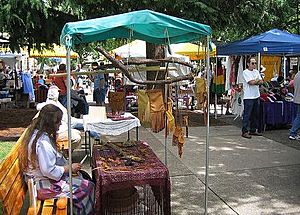
Eugene has many people who like new and different ideas. It also has a large original hippie population. Starting in the 1960s, the ideas of local writer Ken Kesey became a big part of Eugene's culture. Kesey is famous for his book One Flew Over the Cuckoo's Nest.
In 2005, the city council approved a new slogan: "World's Greatest City for the Arts & Outdoors." Locals often found this slogan a bit much. In 2010, it was changed to "A Great City for the Arts & Outdoors."
Eugene's Saturday Market is open every Saturday from April to November. It was the first "Saturday Market" in the United States, starting in 1970. All vendors must make or grow their own products. During the holidays, it becomes the "Holiday Market" at the fairgrounds.
Community Spirit
Eugene is known for its "community inventiveness." Many trends in community development in the U.S. started here. The University of Oregon's special planning process, called The Oregon Experiment, came from student protests in the early 1970s. This process was created by Christopher Alexander, whose work also inspired the creation of the Wiki.
In the 1970s, Eugene had many cooperative and community projects. It still has small natural food stores and some of the oldest student cooperatives in the country. Alternative schools have been part of the school district since 1971. The old Grower's Market downtown is a unique food cooperative with no employees. Newer projects like Square One Villages also show Eugene's focus on community.
In 2003, neighbors noticed an old orchard was for sale. They formed a group called Madison Meadow in 2004 to buy the land. They wanted to keep it as an open space forever. By 2008, they had raised enough money to buy the property.
The City of Eugene has an active Neighborhood Program. Several neighborhoods are known for their green activities. The Friendly Neighborhood has a popular community garden. There are many community gardens on public land. The Amazon Neighborhood has a former church that is now a community center. The Whiteaker neighborhood has a housing co-op that turned its parking lots into food gardens. The Jefferson Westside neighborhood has a unique eco-village with natural buildings and a shared garden. In the River Road Neighborhood, many homes are replacing lawns with gardens. They are also installing systems to collect rainwater and use solar power.
Yearly Cultural Events
- The Asian Celebration, held in late July at Alton Baker Park, celebrates Asian culture.
- The KLCC Microbrew Festival in February introduces many craft beers.
- Mount Pisgah Arboretum hosts a Wildflower Festival in May and a Mushroom Festival in October.
- The Oregon Bach Festival is a big international music festival in July.
- The nonprofit Oregon Country Fair happens in July in nearby Veneta.
- The Lane County Fair takes place in July at the fairgrounds.
- The Eugene/Springfield Pride Festival is held every August at Alton Baker Park. It's a fun event for the LGBT community, families, and friends.
- The Eugene Celebration is a three-day party in downtown Eugene in August or September. The SLUG Queen coronation is part of this, where a new "SLUG Queen" is crowned.
Museums to Visit
Eugene has several museums:
- The University of Oregon's Jordan Schnitzer Museum of Art
- The Museum of Natural and Cultural History
- The Oregon Air and Space Museum
- Lane County History Museum
- Maude Kerns Art Center
- Shelton McMurphey Johnson House
- The Eugene Science Center
Performing Arts
Eugene is home to many cultural groups, including the Eugene Symphony, the Eugene Ballet, and the Eugene Opera. Other groups include the Eugene Concert Choir, the Oregon Mozart Players, and the Oregon Bach Festival. Main places for performances are the Hult Center for the Performing Arts, The John G. Shedd Institute for the Arts ("The Shedd"), and the McDonald Theatre.
The University of Oregon's School of Music and Dance also brings talented performers to Eugene. They often perform at Beall Concert Hall.
Several live theater groups are based in Eugene, such as Free Shakespeare in the Park, Oregon Contemporary Theatre, and The Very Little Theatre.
Music Scene
Eugene, as a college town, has been home to many types of music and musicians. These include electronic dance music, garage rock, hip hop, folk, and heavy metal. There are also growing reggae and bluegrass scenes. The band the Cherry Poppin' Daddies became well-known in Eugene and later nationally. Rock band Floater and blues band Robert Cray also started here.
Mason Williams, who wrote "Classical Gas" and won two Grammy awards, lives in Eugene. He puts on a yearly Christmas show at the Hult Center.
Dick Hyman, a famous jazz pianist, hosts the annual Now Hear This! jazz festival. Eugene also has a large Zimbabwean music community. The city is even mentioned in the Johnny Cash song "Lumberjack."
Visual Arts
Eugene's visual arts community is supported by over 20 private art galleries. Organizations like Maude Kerns Art Center and the Eugene Glass School also help.
In 2015, art by a group from Eugene called Light At Play was shown around the world. This included displays at the Smithsonian.
Film in Eugene
The Eugene area has been used as a filming location for several Hollywood movies.
- The most famous is National Lampoon's Animal House (1978).
- Getting Straight (1969) was filmed at Lane Community College.
- A scene from the 1970 movie Five Easy Pieces was filmed at a Denny's restaurant near Eugene.
- Jack Nicholson directed the 1971 film Drive, He Said in Eugene.
- How to Beat the High Cost of Living (1979) was filmed in Eugene.
- Several track and field movies have used Eugene as a setting. These include Personal Best (1982), Prefontaine (1997), and Without Limits (1998).
- The 2003 independent film Stealing Time was partly filmed in Eugene.
- Zerophilia was filmed in Eugene in 2006.
- The 2016 film Tracktown was about a runner training for the Olympics in Eugene.
Religion in Eugene
Religious schools in Eugene include Bushnell University and New Hope Christian College. Bushnell University is connected to the Christian Church (Disciples of Christ). New Hope Christian College started from a movement in 1915.
Eugene has two Eastern Orthodox Church parishes: St John the Wonderworker and Saint George Greek Orthodox Church.
There are six Roman Catholic churches in Eugene: St. Mary Catholic Church, St. Jude, St. Mark, St. Peter, St. Paul, and St. Thomas More. There is also a Ukrainian Catholic Church.
Mainline Protestant churches include Central Lutheran and the Episcopal Church of the Resurrection.
The LDS Church has a strong presence in Eugene, with 23 congregations. In 2020, the Church announced plans to build a temple in Eugene.
The Reconstructionist Temple Beth Israel is Eugene's largest Jewish congregation. There is also an Orthodox congregation.
Eugene has a community of about 140 Sikhs and a Sikh temple.
The Unitarian Universalist Church in Eugene bought a new building in 2010 and started services there in 2012.
Saraha Nyingma Buddhist Temple opened in Eugene in 2012.
The First Congregational Church, UCC, is a large Christian Church that focuses on justice. They work with a program to provide temporary homes for families without housing.
Sports in Eugene
Eugene calls itself "Track Town USA." This is because of the strong connections between the University of Oregon's track & field program, the Oregon Track Club, and Nike, Inc. Nike was founded by University of Oregon track athlete Phil Knight and his coach, Bill Bowerman.
Eugene has many miles of running trails in its large park system. Famous trails include Pre's Trail in Alton Baker Park and Rexius Trail. There are also many trails along the Willamette River and Amazon Creek.
Jogging was first introduced to the U.S. in Eugene by Bill Bowerman. He wrote a best-selling book called "Jogging." During his time as coach, his "Men of Oregon" won many national titles. Bowerman also invented the waffle sole for running shoes in Eugene.
The city has many running clubs. Eugene is home to the University of Oregon's Hayward Field track. This field hosts many track and field events, including the Prefontaine Classic. Hayward Field has hosted the U.S. Olympic trials many times. Eugene was also the host of the 2021 World Athletics Championships.
Eugene's Oregon Ducks play in the Big Ten Conference. American football is very popular, with big rivalries against the Oregon State University Beavers and the University of Washington Huskies. Autzen Stadium is where the Ducks play football, and it can hold 54,000 fans. The basketball arena, Matthew Knight Arena, was built in 2010.
The Nationwide Tour golf event, Oregon Classic, takes place north of Eugene.
Eugene is also home to the Eugene Emeralds, a minor-league baseball team. They play at PK Park. The Eugene Jr. Generals are a junior ice hockey team that plays at the Lane County Ice Center. Lane United FC, a soccer club, plays at Civic Park.
Here are some sports clubs in Eugene:
| Club | Sport | Founded | League | Venue |
|---|---|---|---|---|
| University of Oregon Ducks | Football, Basketball, Track and Field, Softball, Volleyball, Golf, Tennis, Baseball, Lacrosse, Ice hockey, Soccer, Ultimate | 1876 | National Collegiate Athletic Association: Big Ten Conference | Autzen Stadium, Matthew Knight Arena, PK Park, Hayward Field |
| Bushnell University Beacons | Baseball, Basketball, Beach Volleyball, Cross Country, Distance Track, Golf, Soccer, Softball, Volleyball | 1895 | National Association of Intercollegiate Athletics, Cascade Collegiate Conference | Morse Event Center |
| New Hope Christian College Deacons | Basketball, Soccer, Volleyball | 1925 | Rexius Event Center | |
| Eugene Emeralds | Baseball | 1955 | Northwest League | PK Park |
| Lane Community College Titans | Basketball, Cross Country, Track and Field, Soccer, Baseball | 1965 | Northwest Athletic Association of Community Colleges | Lane Community College |
| Eugene Gentlemen | Rugby | 1973 | Pacific Northwest Rugby Football Union | |
| Eugene Chargers | Basketball | 2006 | International Basketball League | Morse Event Center |
| Eugene Generals | Ice hockey | 2005 | Junior A Tier III-League Hockey: Northern Pacific Hockey League | Lane County Ice Center |
| Lane United FC | Soccer | 2013 | USL League Two | Civic Park |
Parks and Recreation
Spencer Butte Park, at the edge of town, offers access to Spencer Butte, a big hill that can be seen from much of Eugene. Hendricks Park, east of downtown, is known for its beautiful rhododendron garden. It also has a memorial to runner Steve Prefontaine, called Pre's Rock, where he passed away. Alton Baker Park, next to the Willamette River, contains Pre's Trail.
Also by the Willamette River are Skinner Butte Park and the Owen Memorial Rose Garden. This garden has over 4,500 roses of more than 400 types. It also has a 150-year-old Black Tartarian Cherry tree, which is an Oregon Heritage Tree.
Eugene has an urban forest with many trees. The University of Oregon campus is like an arboretum, with over 500 types of trees. The city also has scenic hiking trails through the hills in the southern part of the city. Some trails allow biking, while others are just for hikers and runners.
The closest ski resort, Willamette Pass, is about an hour away by car. Along the way, you can find reservoirs, lakes, mountain biking trails in Oakridge, hot springs, and waterfalls. Eugene residents also visit the Hoodoo and Mount Bachelor ski resorts. The Three Sisters Wilderness, the Oregon Dunes National Recreation Area, and Smith Rock are also close by.
Education in Eugene
Colleges and Universities
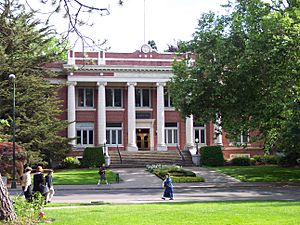
Eugene is home to the University of Oregon. Other colleges include Bushnell University, Lane Community College, New Hope Christian College, Gutenberg College, and Pacific University's Eugene campus.
All of Lane County is part of the Lane Community College district.
Schools for Kids
The Eugene School District covers about 85% of Eugene. The rest of Eugene's northwest neighborhoods are in the Bethel School District.
The Eugene School District has four main high schools: Churchill, North Eugene, Sheldon, and South Eugene. It also has many special programs, like international schools and charter schools. You can find foreign language immersion programs in Spanish, French, Chinese, and Japanese.
The Bethel School District serves children in the Bethel neighborhood. It has Willamette High School and the alternative Kalapuya High School. There are 11 schools in this district.
Eugene also has several private schools, such as the Eugene Waldorf School and Marist Catholic High School.
Libraries
The largest library in Oregon is the University of Oregon's Knight Library. It has over 3 million books and many audio and video items. The Eugene Public Library moved into a new, larger building downtown in 2002. It grew from 38,000 to 130,000 square feet (3,530 to 12,077 m2). There are also two branches of the Eugene Public Library: the Sheldon Branch and the Bethel Branch. Eugene also has the Lane County Law Library.
Media in Eugene
Print Media
The biggest newspaper in the area is The Register-Guard. It's a daily newspaper. Other newspapers include the Eugene Weekly and the Emerald, which is the student newspaper at the University of Oregon. The Torch is the student newspaper at Lane Community College.
Magazines like Eugene Magazine and Lifestyle Quarterly also serve the area. Adelante Latino is a Spanish language newspaper for Lane County.
Television Stations
Local TV stations in Eugene include:
- KEZI (channel 9) (ABC)
- KVAL (channel 13) (CBS)
- KMTR (channel 16) (NBC/The CW)
- KEVU-CD (channel 23)
- KEPB (channel 28) (PBS)
- KLSR (channel 34) (Fox)
- KTVC (channel 36) (independent)
Radio Stations
The local NPR stations are KOPB and KLCC. KRVM-AM is part of Jefferson Public Radio. The Pacifica Radio station is KWVA, run by University of Oregon students. Other local stations include KWAX (classical music) and KRVM-FM (alternative music).
Transportation in Eugene
Bus Services
Lane Transit District (LTD) is the public bus system. It covers about 240 square miles (620 km2) of Lane County. LTD operates over 90 buses and carries millions of riders each year. LTD also has a special bus line called Emerald Express (EmX) that runs between Eugene and Springfield. LTD's main bus station in Eugene is the Eugene Station.
Greyhound Lines also provides bus service through Eugene.
Biking in Eugene
Biking is very popular in Eugene, and many people ride bikes to work or school. During summer events, there are often special parking areas for hundreds of bikes. Many people bike all year long. PeaceHealth Rides is a bike share system that offers 300 city-owned bikes for public use.
Bike trails go along the Willamette River, past a rose garden, through downtown, and through the University of Oregon campus. Eugene is also close to many mountain bike trails.
In 2009, Eugene was named one of the top 10 "Gold-level" cities in the U.S. for its commitment to biking. In 2010, Bicycling magazine called Eugene the 5th most bike-friendly city in America. In 2011, about 7.3% of people in Eugene commuted by bicycle. This was much higher than the national average.
Train Travel
The Amtrak depot downtown was restored in 2004. It is the end point for two daily Cascades trains and a stop for the daily Coast Starlight train.
Air Travel
Air travel is served by the Eugene Airport, also known as Mahlon Sweet Field. It is the second largest airport in Oregon. The Eugene area also has several smaller private airports and heliports.
Highways
Major highways in and around Eugene include:
- Interstate 5: This highway forms much of the eastern city limit and separates Eugene from Springfield. It goes north to Portland and south to southern Oregon.
- Officer Chris Kilcullen Memorial Highway: This highway runs along the Eugene-Springfield Highway. Part of it is also called Interstate 105. It goes west to Florence and east across the Cascades.
- Randy Papé Beltline: This is a freeway that runs along the northern and western edges of Eugene.
- Delta Highway: This short highway connects Interstate 105 and Beltline Highway.
- Oregon Route 99: This highway branches off Interstate 5 south of Eugene. It is a main road in Eugene and continues north through scenic farmlands.
Utilities and Healthcare
Eugene is home to Oregon's largest publicly owned water and power company, the Eugene Water & Electric Board (EWEB). EWEB started in the early 1900s to provide clean water. They also generate electricity from hydropower plants.
Natural gas service is provided by NW Natural. Wastewater treatment is handled by a partnership between Eugene, Springfield, and Lane County.
Two hospitals serve the Eugene-Springfield area: McKenzie-Willamette Medical Center and Sacred Heart Medical Center at RiverBend (both in Springfield). Oregon Medical Group and PeaceHealth Medical Group operate several clinics in Eugene. White Bird Clinic and Volunteers in Medicine & Occupy Medical clinics offer low-cost or free medical care.
Eugene is one of the few cities in the U.S. that does not add fluoride to its water supply.
Famous People from Eugene
Many interesting people have come from Eugene, Oregon.
Sister Cities
Eugene has four sister cities:
See also
 In Spanish: Eugene (Oregón) para niños
In Spanish: Eugene (Oregón) para niños



